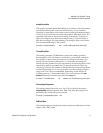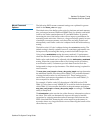
StorNext File System Tuning
The Distributed LAN (Disk Proxy) Networks
StorNext File System Tuning Guide 18
SNFS External API 0
The SNFS External API might be useful in some scenarios because it
offers programmatic use of special SNFS performance capabilities such as
affinities, preallocation, and quality of service. For more information, see
the
Quality of Service chapter of the StorNext User’s Guide API Guide.
The Distributed LAN (Disk Proxy) Networks
As with any client/server protocol, SNFS Distributed LAN performance
is subject to the limitations of the underlying network. Therefore, it is
strongly recommended that you use Gigabit (1000BaseT) for Distributed
LAN traffic. Neither TCP offload nor jumbo frames are required.
Hardware Configuration 0
SNFS Distributed LAN can easily fill several Gigabit Ethernets with data,
so take special care when selecting and configuring the switches used to
interconnect SNFS Distributed LAN clients and servers. Ensure that your
network switches have enough internal bandwidth to handle all of the
anticipated traffic between all Distributed LAN clients and servers
connected to them.
A network switch that is dropping packets will cause TCP
retransmissions. This can be easily observed on both Linux and Windows
platforms by using the netstat -s command while Distributed LAN is in
progress. Reducing the TCP window size used by Distributed LAN might
also help with an oversubscribed network switch. The Windows client
Distributed LAN tab and the Linux dpserver file contain the tuning
parameter for the TCP window size. Note that Distributed LAN server
remounts are required after changing this parameter.
It is best practice to have all SNFS Distributed LAN clients and servers
directly attached to the same network switch. A router between a
Distributed LAN client and server could be easily overwhelmed by the
data rates required.
It is critical to ensure that speed/duplex settings are correct, as this will
severely impact performance. Most of the time auto-detect is the correct
setting. Some managed switches allow setting speed/duplex, such as
1000Mb/full, which disables auto-detect and requires the host to be set
exactly the same. However, performance is severely impacted if the
settings do not match between switch and host. For example, if the switch


















